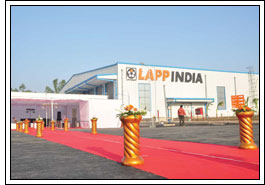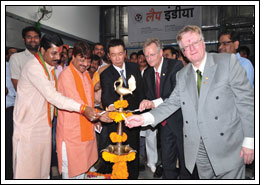 — Richard Lee,
CEO — Asia Pacific, Lapp Group & Acting MD, Lapp India Pvt LtdLapp India
— Richard Lee,
CEO — Asia Pacific, Lapp Group & Acting MD, Lapp India Pvt LtdLapp India is a wholly-owned subsidiary of the Germany-based
Lapp Group and manufactures cables, connectors, cable glands,
conduits and accessories. Lapp India began operations by setting
up a manufacturing facility in Bangalore in 1996. In this interaction
Richard Lee speaks to
Electrical Monitor shortly after Lapp
announced the completion of the first phase of its second
manufacturing plant, at Bhopal, Madhya Pradesh. Expanding
operations in India only reflects Lapp Group’s bullishness on the
subcontinent, feels Richard Lee.
At the outset, please tell us about the newly-commissioned
Bhopal manufacturing plant of Lapp India. What type of cables
will be manufactured here?
Lapp India recently announced the completion of Phase 1 of its
second manufacturing plant in India. A total of Rs.150 crore is
being invested to set up this four-phased cable manufacturing
plant in Pilukedi, Rajgrah District of Bhopal. The Bhopal plant is
the second Lapp India facility in India after Bangalore and is
spread over an area of 117,000 sqm. The Bhopal plant
construction is expected to be completed over a period of five
years and will become Lapp Group’s largest facility globally.
With an initial investment of Rs.50 crore, the first phase of
the plant will produce 1,000 km of single core cables daily,
catering mainly to the Building Cable Segment (BCS).
How do you see the Bhopal plant improving Lapp India’s
penetration in the north Indian markets?
Expanding our operations in India has been a key focus for us at
Lapp Group, mainly due to promising growth opportunities
presented by the country. This year Lapp India’s growth has
increased to 23 per cent compared to last year and the setting
up of this new facility in Bhopal will help us cater efficiently to
growing customer demands. The market size for single core
wires (in the building segment) today stands at approximately
Rs.6,000 crore which indicates a large market opportunity in
this sector. With respect to Lapp range of products, the
addressable cable market in India is currently being valued at
Rs.1,000 crore. We, at Lapp, have identified this opportunity in
India for single core cables and are strengthening our base
accordingly.
In terms of the location of the plant, Bhopal provides a
strategic geographic advantage. Being centrally located in the
heart of India, the facility in Bhopal will be well-equipped to
meet the logistical requirements of the northern and eastern
parts of India and cater to increased demand across India.
 Tell us more on the future phase-wise expansion plan at the
Bhopal unit.
Tell us more on the future phase-wise expansion plan at the
Bhopal unit.
The construction of the entire factory in Bhopal has been
divided into four phases with the currently operational Phase-1
focusing on production of single core cable. The latter phases will focus on producing multi-core cables, aluminium cables
and HT/LT cables respectively.
As mentioned earlier, the four-phased plant construction is
expected to be completed over a period of five years and will
become Lapp Group’s largest facility globally.
Tell us about your leading brand Olflex. Who are the major
consumers of Olflex in India? How do you customize Olflex to
meet Indian requirements?In the 1950s, the upswing in industrialization led to a huge
demand for cables and conductors. Faced with this
development, Oskar Lapp asked himself a simple question:
"How can I optimize the current method — the time-consuming
manual inserting of single cores and switching strands into the
outer sheaths?" His answer: to invent the first industrially
produced flexible, colour-coded signal cable — ÖLFLEX®.
ÖLFLEX derives its name from Öl – meaning Oil in German
and Flex – for flex cable. So therefore, ÖLFLEX means an oil
resistant flexible connecting and control cable. In 1959,
ÖLFLEX® was the very first control cable to be designed with
colour-coded wires and was at the same time the first branded
cable in the world. Today, ÖLFLEX® connecting and control
cables are some of the most widely used in the world, and for
good reason!
ÖLFLEX® are the universal cables used in control
application and besides being the first multi core cable to be
manufactured in the world, these cables are suitable for 3 axis
rotation applications and also for applications with very high
linear bending stress. ÖLFLEX cables are the only choice when
it comes to machine tool applications as these are oil and
chemical resistant. Just to add on, this world-renowned cable
celebrated 50 great years of success recently in the year 2010.
When Oskar Lapp, the founder of the company invented the
first industrially produced connecting and control cable under
the name of ÖLFLEX® 50 years ago, people were little aware of
the unique success story that this cable brand would go on to
write. Used globally, from the mountains of Himalayas to the
deserts in Egypt, testify the quality, all-purpose utility and
resistance of this cable.
ÖLFLEX is LAPP’s flagship brand. It is a brand with which
Lapp is largely synonymous with worldwide. We are trying to do
the same in India, where we have had significant presence for
the past 12 years. Many of our customers know "control cables"
as ÖLFLEX; our pursuit to make ÖLFLEX a synonym with control
cables continues. Apart from making the conventional Olflex
cables as made in Germany, we are also making ÖLFLEX cables
suited for the Indian market. We have made variants to comply
with Indian standards.
We understand that Lapp India had formed a Building Solutions
Segment for providing wiring solutions to the building segment.
How is this new line of business doing?
With growing awareness about safety and efficient use of
energy in the building sector, the Building Connectivity
Solutions division of the organization is expected to be the next
growth booster for Lapp India. In the last one year, we at Lapp
India, have made substantial inroads into the building segment
especially in projects for SEZs, gated communities, etc.
The market size for single core wires in the building segment
today stands at approximately Rs.6,000 crore indicating a large
market opportunity in this sector. With respect to LAPP range
of products, the addressable cable market in India is currently
being valued at Rs.1,000 crore. We, at LAPP, have identified
this opportunity in India in the building segment and are
strengthening our base accordingly by focusing on the
production of single core cables targeted to the building
segment through the set-up of phase one of the Bhopal facility.
 The electrical equipment industry has seen a downturn this
year. What is your overall view and what is your take on
prospects for the cables industry?
The electrical equipment industry has seen a downturn this
year. What is your overall view and what is your take on
prospects for the cables industry?
At Lapp India, we manufacture cables catering to all
connectivity requirements for an expanse of verticals including
wind, solar, automation, automobile, building connectivity,
machine tool, process, solar, and even public sector.
Therefore, for Lapp India, the opportunity to grow will continue
to exist as there will always be a continuous demand for cables
irrespective of market conditions.
An initiative that is helping us stay resilient through change
is The Lapp Operating System (LOS), a global initiative of the
Lapp Group. The LOS is an organizational concept to
manufacture the best of products for our customers with
complete involvement of all the employees by eliminating
wastage; ensuring the highest quality and on-time delivery. As the result of this activity, we hope to reduce up to 30 per cent
overall inventory, thereby reducing overall operating
expenses.
Furthermore, we are increasing our focus on customers; in
line with our guiding principles of being customer centric, we
are focusing on our customers’ connectivity requirements to
improve efficiency of operations. Additionally, we are looking
towards a thrust in terms of sales and also increasing our order
inflow, which will continue our growth.
Please summarize key future plans of Lapp India and discuss
India’s role in Lapp’s global business portfolio.
Lapp cables have large popularity in the machine tool industry,
automobile sectors and our flagship product ÖLFLEX® is
popular across the industries. Further, we are increasing
capacity to focus on verticals like renewable (solar and wind),
Building Connectivity Solutions and instrumentation cables for
process industries. Our customized cables have applications
across every domain, this coupled with quality we predict
significant growth in our business.
Cables are a key component of solar panels and modules,
with huge government thrust and subsidies for solar energy,
this sector has huge business potential for us. While the
Government has given out licences for lot of megawatt of solar
energy, only a fraction of that has been deployed. However,
now with states such as Gujarat, Karnataka, Madhya Pradesh
and Rajasthan moving forward to deploy solar power plants,
there is lot of scope for Lapp India in the domestic market.
Also, the Building Connectivity Solutions division is currently
a key focus for us at Lapp India, in view of the huge market
opportunity identified in this segment. In line with this, Lapp
India has recently inaugurated phase one of its second cable
manufacturing facility in Bhopal, Madhya Pradesh which will
produce 1,000 km of single core cables daily, catering mainly to
the BSC segment. The Bhopal plant has been divided into four
phases and will be completed over a period of five years, post
which it will become Lapp Group’s largest facility globally. As a
result of this, Lapp India, being the second largest segment
within the Lapp family, is well poised to become the biggest
player in the Lapp Group in a few years time.
Further, with the state-of-the art manufacturing facility in
Jigani, Bangalore nearing its full capacity we plan to invest in
expansion of the Bangalore plant. This will help us gear up to meet
India’s growing domestic needs. Further the tier-II and III cities
have been developing vigorously and we have been witnessing
good demand from these regions. Hence we are focusing our
efforts on exploring the market potential in these regions by
educating buyers about the significance of quality products as
opposed to the low-priced sub-standard products.